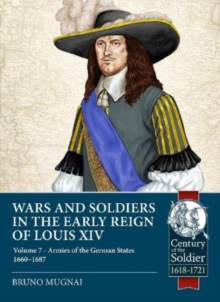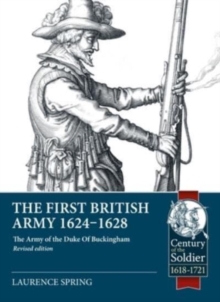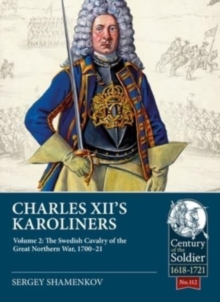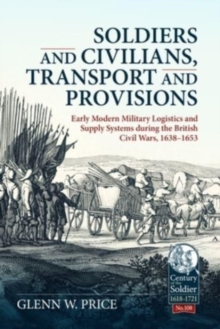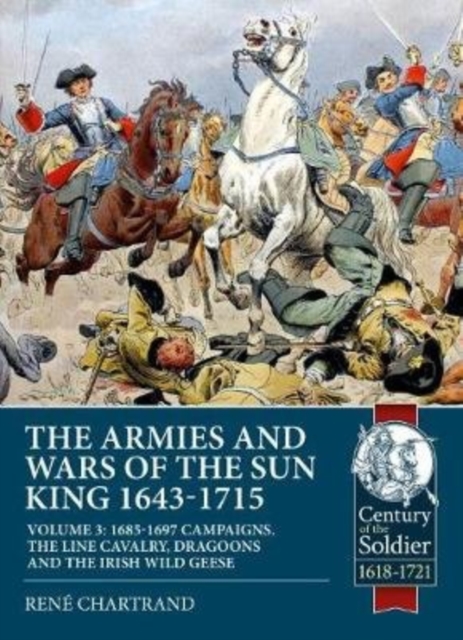
The Armies and Wars of the Sun King 1643-1715 : Volume 3: 1685-1697 Campaigns, the Line Cavalry, Dragoons and the Irish Wild Geese Paperback / softback
by Rene Chartrand
Part of the Century of the Soldier series
Paperback / softback
- Information
Description
The volume starts in an age of intolerance: the Protestant tragedy in France and the Irish tragedy.
Tens of thousands of Protestants fled France. Various military and political events of the later 1680s, notably the "Glorious Revolution" of 1688 that chased out King James II and installed William of Orange as King William III of Great Britain led to hostilities in 1689-1691 with Ireland being secured by William.
Both had considerable impact on the armies of western Europe.
Tens of thousands of officers and soldiers fled France for other nations and also left Ireland for France and later Spain.
Much has been said about the loss of Protestant soldiers to the French army, but less known is that the Irish Catholic military refugees certainly compensated losses in the French army and later also boosted the Spanish army. William's accession to the British throne also meant that Great Britain resolutely now joined the Holy Roman Empire, the Netherlands, Brandenburg-Prussia and other nations opposed to Louis XIV's France that formed the League of Augsburg.
In effect, Britain joined Europe in a large military alliance and all-out war broke out in 1689.
This was not good news for Louis XIV; although the British army was not formidable, it was an efficient force and a large part of it would, for the first time, join its allies on the continent.
The other main European armies had also learned a lot from the French army and had adopted many of its features; the Blitzkrieg campaigns were over.
In the successive battles and sieges of the war, the allied armies could equal the French in combat, but the Sun King's commanders, on the whole, were still the finest.
Cohesion in command plagued the allies, but good commanders were rising there too, notably Prince Eugene of the imperial army.
Several chapters will go through the campaigns on the two main fronts: Flanders and western Germany, and Catalonia in Spain.
On the whole, the early battles such as Fleurus, Leuze, Steenkirk and Neerwinden were hard-won successes for the French armies; there were many sieges and the two of Namur (1692 captured by the French, retaken by the allies in 1695) stand out.
By 1697, all belligerents were nearly exhausted, but the French army prevailed in Catalonia and took Barcelona. Peace was concluded shortly thereafter and it was a draw as to who really won the war.
An important topic, sometime noted in histories, but rarely faced is the brutality and cruelty by soldiers on largely defenceless civilians as well as the devastation, sacking and burning of homes, villages and towns attained new dimensions during this period.
Encouraged by government authority, the persecution of Protestants within France and of Catholics in Ireland showed that such behaviour by French and British troops on their own populations could even be rewarded with approval by the righteous church and state.
With instructions from Minister of War Louvois, troops were specifically encouraged to devastate the Palatinate including the outrageous destruction of the university town of Heidelberg.
However, after the passing of Louvois in 1691 and the exile and subjection of Ireland, there was certainly disgust and a realisation that hatred had its limits.
Some civility reappeared by the mid-1690s and would eventually evolve into the 18th century mannerism of the so-called "Lace Wars".
The French army in the west still relied on the Ottoman Turks to keep a good part of the Austrian and German state armies watching their eastern borders.
The failure of the 1683 siege of Vienna had certainly not ended the Ottoman menace and much more fighting went on in the 1680s and 1690s.
The end of the 17th century saw the beginnings of the rise of Russia under its extraordinary Tzar Peter I and also of Prussia at the expense of Poland and Sweden in a complex situation that went into the early 18th century.
The Dutch War had given rise to very numerous armies and the War of the League of Augsburg attained new heights with French armies in the field nearing half a million men.
Clearly, recruiting volunteers had reached its limits and, in late 1688, the Sun King created the Royal Militia that heralded large-scale obligatory military service in modern Europe.
From then on, the Sun King could enlist tens of thousands of, usually, peasants to fill the ranks of the numerous armies he maintained.
Maintaining such forces required considerable funds that taxes simply could not meet.
Various extra taxes were introduced in France, with very limited success so that borrowing ended up being the main option.
The fiscal pressure was also tremendous on the opposing allied armies either directly through their own taxes and also with subsidies from the more capitalised trading countries, England and the Netherlands, whose almost untenable credit situation led to the creation of Bank of England - the first modern government bank - to manage credit and debt.
France and Austria did not create such banks yet but managed these aspects well so that there were enough funds to field huge armies on both sides, but not indefinitely.
Part 2 The Cavalry. This section describes what was by very far Europe's largest cavalry force.
It included the Gendarmerie de France, which was a privileged division between the guards and the line cavalry.
The line cavalry evolved from a fairly standard heavy cavalry force in the 1640s to a more complex arm of the service that first added numerous dragoon regiments in the 1670s, a division of rifled-armed elite carabiniers in the 1690s and also the advent of Hussars as light cavalry at that time.
The peculiar organisation of the cavalry with its Mestre de Camp General, Colonel General is also described and some of its personalities had rather colourful careers.
Arms, accoutrements and dress of the cavalry are discussed and also, the horses and the never-attained challenge of furnishing enough for some 60,000 troopers in the 1690s.
By comparison, British cavalry hovered at about 7,000.
This included efforts to develop better breeding and the advent of "dressage" as we know it today from France's Louis XIVs era.
The Wild Geese This expatriate force of Irish officers and men formed quite a different type of force.
They were not mercenaries as other foreign regiments.
They either belonged to the army that came with James II to France and, in the 1690s, formed his distinct army or served in the Irish regiments that formed a division within the French army.
The Sun King subsided everything and it was a very good investment.
One benefit was that he gained Berwick, a leading future marshal of France.
The Irish were fine soldiers and, in time, also integrated into French society with success in government and business besides the army. As in previous volumes, the last part of Vol. 3 features a large appendice listing all the regiments of the French cavalry from 1643 to 1715.
Other appendices concern uniforms as described in the main contemporary sources.
There will further be at least one appendice on opponent armies, certainly the Austrian army in this volume.
Another topic is a list of French Protestant regiments in the British army.
Information
-
Out of StockMore expected soonContact us for further information
- Format:Paperback / softback
- Pages:312 pages, 42 colour ills, c 200 b/w ills
- Publisher:Helion & Company
- Publication Date:01/10/2020
- Category:
- ISBN:9781913118853
Information
-
Out of StockMore expected soonContact us for further information
- Format:Paperback / softback
- Pages:312 pages, 42 colour ills, c 200 b/w ills
- Publisher:Helion & Company
- Publication Date:01/10/2020
- Category:
- ISBN:9781913118853
